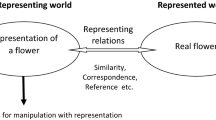Abstract
Mental imagery is the human ability to imagine and reason with visuo-spatial information. It is crucial for everyday tasks such as describing a route or remembering the form of objects. The so-called imagery debate has been centered around the question how mental imagery is realized, i.e., what structures and algorithms can plausibly explain and model mental imagery. There is, however, little progress on a coherent theory that can sufficiently cover the diversity of the empirical data. This article presents a new theory of mental imagery, which in contrast to other contemporary theories is formalized as a computational cognitive model. We will compare this theory to the contemporary theories using two representative phenomena of mental imagery. We will argue that formalized theories can advance the currently stagnant imagery debate.




Similar content being viewed by others
Notes
Cognitive Penetration is explained, for example, in ([8], p. 161).
References
Denis M, Kosslyn S (1999) Scanning visual mental images: a window on the mind. Cahiers Psychol Cogn 18:409–465
Finke RA, Pinker S, Farah MJ (1989) Reinterpreting visual patterns in mental imagery. Cogn Sci 13:51–78
Kosslyn SM (1980) Image and mind. Harvard University Press, Cambridge
Kosslyn SM (1994) Image and brain: the resolution of the imagery debate. MIT Press, Cambridge
Kosslyn SM, Thompson WL, Ganis G (2006) The case for mental imagery. Oxford University Press, New York
Peterson MA, Kihlstrom JF, Rose PM, Glisky LM (1992) Mental images can be ambiguous: reconstruals and reference-frame reversals. Mem Cogn 20(2):107–123
Pylyshyn ZW (1981) The imagery debate: analogue media versus tacit knowledge. Psychol Rev 88:16–45
Pylyshyn ZW (2002) Mental imagery: in search of a theory. Behav Brain Sci 25(2):157–238
Pylyshyn ZW (2003) Seeing and visualizing: it’s not what you think. MIT Press, Cambridge
Richman CL, Mitchell DB, Reznick JS (1979) Mental travel: some reservations. J Exp Psychol Hum Percept Perform 5(1):13–18
Searle JR (1980) Minds, brains, and programs. Behav Brain Sci 3:417–424
Sima JF (2011) The nature of mental images—an integrative computational theory. In: Carlson L, Hoelscher C, Shipley T (eds) Proceedings of the 33rd annual conference of the cognitive science society, Austin, TX, pp 2878–2883
Slezak P (1995) The ‘philosophical’ case against visual imagery. In: Slezak P, Caelli T (eds) Perspective on cognitive science: theories, experiments, and foundations, Ablex, Norwood, NJ, pp 237–271
Thomas NJT (1999) Are theories of imagery theories of imagination? An active perception approach to conscious mental content. Cogn Sci 23:207–245
Acknowledgements
This paper presents work done in the project R1-[ImageSpace] of the Transregional Collaborative Research Center SFB/TR 8 Spatial Cognition. Funding by the German Research Foundation (DFG) is gratefully acknowledged.
Author information
Authors and Affiliations
Corresponding author
Rights and permissions
About this article
Cite this article
Sima, J.F., Freksa, C. Towards Computational Cognitive Modeling of Mental Imagery. Künstl Intell 26, 261–267 (2012). https://doi.org/10.1007/s13218-012-0186-3
Received:
Accepted:
Published:
Issue Date:
DOI: https://doi.org/10.1007/s13218-012-0186-3




